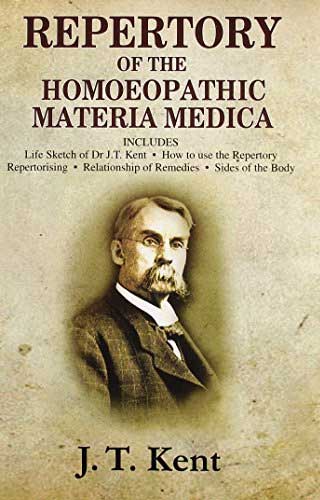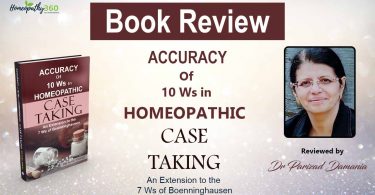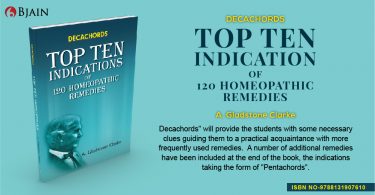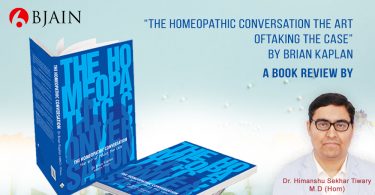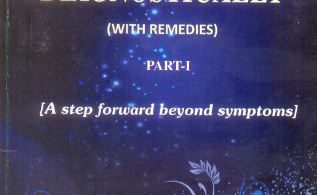A CONCISE ACCOUNT OF THE KENT`S REPERTORY
ABSTRACT
“ Kent still lives ! His influence still shines as a burning torch to reveal truth ! ”
Repertory is a tool that helps a homoeopath for searching similium easily and fastly. In the field of homoeopathy there are many repertories like fragmenta de viribus, Boenninghausen therapeutic pocket book, Boger Boenninghausen`s characteristics and repertory and many more. With the advent of technology now we have many computer repertories also like Hompath, RADAR, CARA, Mac Repertory. Whenever we talk about homoeopathic repertories the most popular , widely used , precursor of almost all modern repertories is center point of discussion as it is like pole star in field of homoeopathic repertory, Repertory of the Homoeopathic materia medica by Dr James Tyler Kent. It proves to be a guiding treatise for many modern repertories. This repertory has been accepted universally as a proper repertory.
KEYWORDS
Kent Repertory, Deductive logic, Generals, Rubrics
INTRODUCTION
Kent repertory is logico-utilitarian group of repertory. Based on deductive logic it follows the principle of general to particular, giving prime importance to generals. In this repertory almost all the sources and recorded symptoms in homoeopathic materia medica have been considered. The Plan is uniform throughout, this repertory starts with MIND chapter, which has been given prime importance and the last chapter is generalities which contains physical generals and physical general modalities. All rubrics arranged alphabetically in all the chapters. Rubrics are arranged from generals to particulars. Generalities section is large and elaborate and it contains many rubrics on general modalities and some rubrics on clinical conditions. Many rubrics which appear as particular under proper anatomical sections or main headings may also appear in this section, if they refer to the general conditions; for example, modalities related to perspiration, menses, food, etc. After the completion of the work Kent started using it in his clinical practice. On demand from the profession it was taken up for publication. As the cost of publication was high it was decided to publish the book in sections and subscriptions were sought from the profession. 200 subscriptions were obtained at $30
- TITLE : Repertory of the homoeopathic materia medica
- AUTHOR : Dr James Tyler Kent { 31 March 1849 – 06 June 1916 }
- Father : Stephen Kent
- Mother : Caroline Tyler
- Birth place : Woodhull, Steuben, New York
- Wife : Ellen (1st wife),
Clara Louise Kent (2nd wife)
- Elementary & Secondary education : Franklin Academy, Prattsburg
- Higher education : Madison (now Colgate) university, Hamilton , New York
- Ph.B (Bachelor of Philosophy) in 1868
- A.M. ( Bachelor of alternative medicine) in 1870
- Educated in medicine
- at Eclectic medical institute, Cincinnati, Ohio in 1871
- At Homoeopathic medical college of Missouri, St. Louis in 1889
- Physician of Eclectic school at St. Louis
- 1877-78 : kent`s wife got seriously ill, all other system of medicine failed & finally through homoeopathy she got cured (By Dr Richard Phelan).
- Treatment of his wife through homoeopathy resulted in conversion of dr kent to homoeopathy.
- 1879 : resigns from Eclectic Medical Association
- 1881-1883 : Chair of Anatomy at Homoeopathic medical college of Missouri
- 1883-1888 : Professor of Materia Medica, Homoeopathic medical college of Missouri, St. Louis
- 1890 – 1899 : Professor Department of materia medica , Dean of Post Graduate School of Homoeopathy , Philadelphia, Pennsylvania
- 1903-1909 : Professor, Department of materia medica, Hahnemann Medical College, Chicago
- Dean & Professor , Department of materia medica , Dunham medical college, Chicago
- Dean & Professor , Department of materia medica , Hering medical college, Chicago
- Member of Illinois State Homoeopathic Medical Society
- Member of American Institute of Homoeopathy
- Member of the International Hahnemannian Association
- Honorary Member in British Homoeopathic Medical Society
- CONTRIBUTIONS & BOOKS BY DR JT KENT :
- Dr Kent became famous as high potency homoeopath, advocated use of 30,200, 1 M, 50 M, CM, DM & MM Potencies.
- He introduced SERIES IN DEGREE in the treatment of chronic diseases. He found when the action of 30 potency is completed, the patients needs 200 potency, when action of 200 potency is exhausted, the patient requires 1M potency and so on.
- Dr Kent laid greatest importance to WILL, UNDERSTANDING & MEMORY of the patient. These form the innermost essence of the man.
- BOOKS :-
- Repertory of the Homoeopathic Materia Medica
- Lectures on Homoeopathic Materia Medica with new remedies.
- Lectures on Homoeopathic Philosophy
- Use of Repertory, How to Study the Repertory, How to use the Repertory
- New Remedies, Clinical cases, Lesser Writings, Aphorisms and Percepts.
- What the Doctor needs to know in order to make a successful Prescription.
- SOURCES OF KENT REPERTORY :
- C. Lipee`s repertory (1879, Repertory of the more characteristic symptoms of materia medica)
- Gentry`s Concordance repertory
- BTPB
- Minton`s uterine therapeutics
- Allen`s Encyclopaedia of homoeopathic materia medica
- Biegler`s diary
- Allen`s symptoms register
- Jahr`s symptoms codex
- YEAR OF PUBLICATION : 1897
Different editions | Year of publication |
1st | 1897 |
2nd | 1908 {Till death of Dr J T Kent} |
3rd | 1924 |
4th | 1935 |
5th | 1945 |
6th | 1957 |
Indian edition (Made from 6th ) | 1961 |
Kent final general repertory (Diwan Harishchand & Pierre Schimdt) | 1974 |
- PREFACE :
- Separate publisher`s preface given for all different editions, in almost all gratitude is expressed to Dr Kent for his valuable contribution to homoeopathy in the form of this repertory.
- In the original edition:
- The plan of repertory is uniform throughout.
- It has been attempted to proceed in every case general to particular.
- Aim has been to give first of all a general rubric containing all the remedies which have produced the symptoms followed by particulars i.e, time of occurrence, the circumstances and lastly the extensions.
- A circumstance that makes the whole being feel better or worse is of much greater importance than when the same circumstance only affects the painful parts.
- It is suggested that those who use this repertory should first of all reads all headings of the general rubrics from the beginning to end & thus become acquainted with the plan of the repertory.
- Only by constant use can any repertory become a companion and a helper.
- PHILOSOPHICAL BACKGROUND :
- Kent’s repertory is based on the philosophy of DEDUCTIVE LOGIC.
- Here generals are dealt with in detail followed by particulars and minute peculiars.
- By working out a case in the other direction i.e. from generals to particulars the general rubric will include all the remedies that are related to the symptom.
- The medicine selected should cover the patient and should cover the pathognomonic symptom. For this find the strange rare and peculiar symptom, see that no generals are contradicting. It will be the similimum. This method was adopted by Kent.
- So under the chapter mind mental generals are given. They contain rubrics related to will /understanding and memory. The physical generals are mostly listed under the chapter generalities and a few in other chapters.
- Three types of grading of remedies:
GRADES | REPRESENTATION | EXAMPLE | MARKS | CRITERIA |
1st | Bold roman | Apis | 3 | * Majority provers have given , * Confirmed in reproving, * Verified on sick |
2nd | Italics | Apis | 2 | * Brought out by few provers, * Confirmed in reproving, * Verified occasionally |
3rd | Roman | Apis | 1 | * In some provers only, * Not confirmed in reproving, * Clinically verified |
- PLAN AND CONSTRUCTION :
- Repertory is divided into 37 chapters (including sub chapters of urinary organs) spanning into 1423 pages arranged in double columns.
CHAPTERS OF KENT REPERTORY | |
| 20. Prostate gland |
| 21. Urethra |
| 22. Urine |
| 23. Genitalia male |
| 24. Genitalia female |
| 25. Larynx and trachea |
| 26. Respiration |
| 27. Cough |
| 28. Expectoration |
| 29. Chest |
| 30. Back |
| 31. Extremities |
| 32. Sleep |
| 33. Chill |
| 34. Fever |
| 35. Perspiration |
| 36. Skin |
| 37. Generalities |
| |
- The repertory starts with MIND chapter, which has been given prime importance.
- Last chapter is on generalities which contains physical generals and physical general modalities.
- TOTAL NO. OF REMEDIES : 648
- Six drugs in index are repeated as their synonyms also given so actual remedies = 648 – 6 = 642
DRUG | ITS SYNONYM |
|
|
|
|
|
|
|
|
|
|
|
|
- ARRANGEMENT INSIDE CHAPTERS :
- Rubrics are of two types General Rubrics and Sub rubrics
- All rubrics arranged alphabetically in all the chapters. Rubrics are arranged from generals to particulars.
- A rubric start with general symptom or a state with a list of large group of medicines.
- Side, Time, Modality & Extension – {S T M E} This order is followed generally in each rubric & subrubric.
- Whereever rubrics can be divided into sides, the general rubric is followed immediately by side, firstly right side, then left.
- Time : Dr kent follows the logic of general to particulars.
- Daytime ( fraction of day)
- Morning (fraction)
- Forenoon (fraction)
- Noon (fraction)
- Afternoon (fraction)
- Evening (fraction)
- Twilight (fraction)
- Night (fraction)
- Midnight (fraction)
- After midnight (fraction)
- Modalities : It includes different factors which influence symptoms
- Ailments from
- Alternating with
- Modifying factors, aggravation & amelioration (including concomitant, before, during and after).
- Extension : This is last subrubric and found mainly under ‘pain’ rubric.
- CROSS REFRENCES :
- Found mainly in MIND chapter
- There are 2 types of cross references used in this repertory- SYNONYMS & SIMILAR WORDS.
- SYNONYMS – Main rubric contain synonym in bracket without giving any medicine against it. Helps to locate the appropriate rubric. { MIND– ABANDONED : (See Forsaken)}
- SIMILAR WORDS – Main rubric contain some terms, which are similar in meaning . It also contains a group of medicines. Helps us to compare drugs mentioned at both places.
{ MIND– ABSENT MINDED : (See Forgetful ) ; Acon. – zinc.}
- METHODS OF REPERTORIZATION :
TYPE OF SYMPTOMS | ||
| Mental general –
|
|
Physical general – Sleep, fever, side of body, general sensation, general pathological changes , desire, aversion etc |
| |
|
Modalities of affected part – pain in leg , numbness in calf muscle etc | |
| These are Hahnemann`s general symptoms | Headache, fever, diarrhea, weakness etc |
- ADAPTABILITY OF KENT REPERTORY :
- Most useful in cases where mental symptoms are predominant.
- Cases where generals are prominent.
- Cases where symptoms are well defined.
- Cases where there is presence of characteristic symptoms.
- Cases where symptoms are qualified.
- ADDITIONS IN INDIAN ENRICHED EDITION OF KENT REPERTORY :
- Use of the Repertory by Dr J T Kent
- Symptoms most peculiar to the patient must be taken first, then those less and less peculiar until the symptoms that are common and not peculiar are reached.
- Symptoms to be taken: First-are those relating to the loves and hates, or desires and aversions.
- Next-are those belonging to the rational mind, so-called intellectual mind.
- Thirdly-those belonging to the memory.
- The symptoms that are next most important are those related to the entire man and his entire body or his blood and fluids: as sensitiveness to heat, to cold, to storm, to rest, to night, to day, to time. They include both symptoms and modalities.
- Preference must be given to discharges from ulcers, from uterus during menstruation, from ears, and from other parts, as those are very closely related to the vital operation of the body.
- Next must be used the modalities of the parts affected, and frequently these will be, found to be the very opposite of the modalities of the patient himself.
- The artistic prescriber must study Materia Medica long and earnestly to enable him to fix in his mind sick images, which, when needed, will infill the sick personalities of human beings.
- How to study the Repertory Dr J T Kent
- How to use the Repertory Dr J T Kent
- Repertorising by Dr M L Tyler & John Weir
- Hot and Cold remedies by Dr Gibson Miller
- Remedies predominantly aggravated by COLD
- Remedies predominantly aggravated by HEAT
- Remedies sensitive to both extremes of temperature
- Relationship of remedies and their duration of action by Dr Gibson Miller
- The Sides of the body and Drug affinities by Boger taken from BTPB
- REPERTORIES BASED ON KENT REPERTORY :
- SYNTHETIC REPERTORY (1973, Bartel & klunker)
- SYNTHESIS REPERTORY ( 1993, Frederik schroyens)
- KENT`S REPERTORIUM GENERALE (1987, Jost Kunzli)
- HOMOEOPATHIC MEDICAL REPERTORY (1993, Robin Murphy)
- COMPLETE REPERTORY (1996, Roger Van Zandvoort)
- REPERTORIUM UNIVERSALE (2003, Roger Van Zandvoort)
- SPECIAL FEATURES OF KENT REPERTORY :
- Smallest / largest chapters of Kent`s Repertory :
S. No. | CHAPTER | NO. OF RUBRIC | NO. OF PAGES | REMARK |
1. | MIND | 529 | 95 {1-95} | Largest chapter as per no. of rubrics |
2. | HEARING | 04 | 03 {321-323} | Smallest chapter as per no. of rubrics |
3. | PROSTATE | 21 | 02 {667-668} | Smallest chapter as per no. of pages |
4. | COUGH | 348 | 34 {778- 811} | 2nd largest chapter as per no. of rubrics |
5. | EXTREMITIES | 267 | 282 {952 – 1233} | Largest chapter as per no. of pages |
- Kent’s repertory is based on the philosophy of generals to particulars and it follows this principle in arrangement too, thus making it easier to search for rubrics.
- It contains-648 medicines in the Index (some study finds that only 591 medicines are used) which is more than the other two repertories in use, that is, Therapeutic Pocket Book and Boger’s repertory.
- It has three gradations of medicines – 3, 2, 1, which is more practical unlike five gradations of Boenninghausen and Boger.
- Mind section contains many rubrics and subrubrics. It also contains qualified symptoms, which are very helpful in repertorization.
- Generalities section is large and elaborate and it contains many rubrics on general modalities and some rubrics on clinical conditions. Many rubrics which appear as particular under proper anatomical sections or main headings may also appear in this section, if they refer to the general conditions; for example, modalities related to perspiration, menses, food, etc.
- It contains most of the symptoms related to parts as well as generals, thus one who uses this repertory rarely needs to refer to other repertories.
- Subrubrics are placed alphabetically according to the arrangement. Subrubrics are also given relating to children, which is helpful in narrowing the field of choice.
- CRITICISM OF KENT`S REPERTORY :
- In some parts the rubrics are generalized (chapter mind) where as in some other parts the rubrics over particularized (chapter Extremities).
- Similar rubrics, with different remedies and with different evaluation are given in many chapters. This pose difficulties in working out a case, because the chances of missing out remedy is great. Example – “Liquids taken are forced into nose” (page 454) also under the chapter Nose “Liquids comes out through the nose on attempting to swallow”.
- There are many similar rubrics, which cause confusion for the beginners, thus repertorization becomes difficult for them. For example, fear, timidity, frightened easily, etc.
- Some rubrics, especially subrubrics, with similar meaning appear at different places with slight differences in drugs.
For example:
SYMPTOMS | RUBRICS |
Do not want the doctor. |
|
‘Dislikes opposite sex |
|
- Modalities, which are the main qualifying factors, list different groups of medicines in general rubrics and in subrubrics.
For example:
Head, pain, reading while | In the first rubric, Natrium muriaticum gets high marks, which is not mentioned in the second rubric. |
Head, pain – forehead, reading while. | The second one, though a smaller rubric, contains five medicines, which are not given in the modality of the first (main) rubric. |
- Some Nosodes are found scattered under some rubrics but they are not represented well.
- Many rubrics suffer from omission of drugs. Some information, which is found in the materia medica and even in his Lectures on Materia Medica, does not find a proper place in his repertory, thereby the purpose of indexing remains incomplete.
For example:
Faintness – menses during, Cyclamen is absent, but in his materia medica, this symptom is described under the drug.
CONCLUSION
We all homoeopaths are indebted to Dr Kent for giving us the most proper repertory, the magnum opus of homoeopathic repertory REPERTORY OF THE HOMOEOPATHIC MATERIA MEDICA. Kent repertory is much helpful in different cases and it is easy to understand thus making us frequent user of Kent repertory.
REFERENCE
1. | Kent JT. Repertory of Homoeopathic Materia Medica and a Word Index. New Delhi, India: B Jain; 2004. |
|
|
2. | Kent JT. Lectures on homoeopathic philosophy. Legare Street Press; 2022. |
|
|
3. | Siju PV. Reference to repertories for homeopathic students. New Delhi, India: B Jain; 2023. |
|
|
4. | Tiwari SK. Essentials of repertorization: A comprehensive textbook on case taking & repertorization: 4th edition. 4th ed. New Delhi, India: B Jain; 2023. |
|
|
5. | Me A. Homeobook- everything on Homoeopathy [Internet]. Homeopathy Resource by Homeobook.com. Homeobook; 2016 [cited 2024 Aug 2]. Available from: https://www.homeobook.com/ |
|
|
6. | HOMEOPATHE INTERNATIONAL – ENGLISH [Internet]. Homeoint.org. [cited 2024 Aug 2]. Available from: http://homeoint.org/english/ |
|
|
Title: Repertory of The Homeopathic Materia Medica
Author: James Tyler Kent
ISBN: 9788131900949
Imprint: B Jain Large Print
Pages: 1542
Format: Hard Cover
Language: English
Dr Sushil Rajbhar is *MD Scholar in Department of Homoeopathic Repertory and Case Taking* at Government Homoeopathic Medical college & Hospital Bhopal. He is teacher by passion and doctor by profession. He simplifies the whole studying and teaching process by making lectures comical , by making tricks , inculcating humours. Very keen in academics specially reviewing books and delivering the orginal and authentic data to students. He is a wonderful clinician treating patients, patient care and help them in the process of healing is his another trait. He has successfully cured various cases viz.,Covid like symptoms, Varicose veins, Lipoma, Dengue, Typhoid, UTI, Hairfall, Eczema, Sciatica, Menstrual irregularities cases etc.



